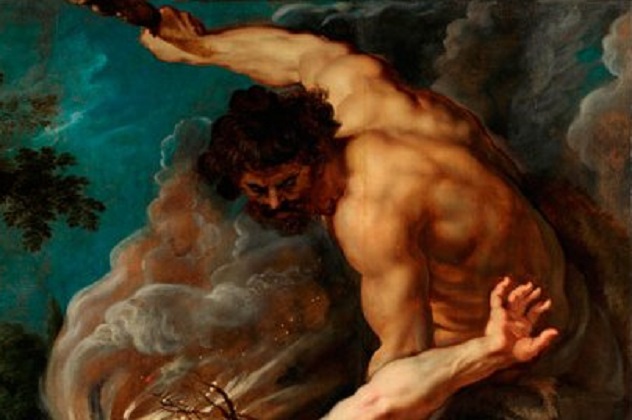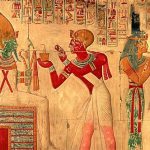 Animals
Animals  Animals
Animals  Weird Stuff
Weird Stuff 10 Weird Things People Used to Do at New Year’s
 Our World
Our World 10 Archaeological Discoveries of 2025 That Refined History
 Weird Stuff
Weird Stuff 10 Fascinating Facts You Might Not Know About Snow
 Miscellaneous
Miscellaneous Top 10 Things Crypto Was Supposed to Change & What Actually Did
 History
History 10 Huge Historical Events That Happened on Christmas Eve
 Music
Music 10 Surprising Origin Stories of Your Favorite Holiday Songs
 History
History 10 Less Than Jolly Events That Occurred on December 25
 Weird Stuff
Weird Stuff 10 Funny Ways That Researchers Overthink Christmas
 Politics
Politics 10 Political Scandals That Sent Crowds Into the Streets
 Animals
Animals 10 Species That Refused to Go Extinct
 Weird Stuff
Weird Stuff 10 Weird Things People Used to Do at New Year’s
 Our World
Our World 10 Archaeological Discoveries of 2025 That Refined History
Who's Behind Listverse?

Jamie Frater
Head Editor
Jamie founded Listverse due to an insatiable desire to share fascinating, obscure, and bizarre facts. He has been a guest speaker on numerous national radio and television stations and is a five time published author.
More About Us Weird Stuff
Weird Stuff 10 Fascinating Facts You Might Not Know About Snow
 Miscellaneous
Miscellaneous Top 10 Things Crypto Was Supposed to Change & What Actually Did
 History
History 10 Huge Historical Events That Happened on Christmas Eve
 Music
Music 10 Surprising Origin Stories of Your Favorite Holiday Songs
 History
History 10 Less Than Jolly Events That Occurred on December 25
 Weird Stuff
Weird Stuff 10 Funny Ways That Researchers Overthink Christmas
 Politics
Politics 10 Political Scandals That Sent Crowds Into the Streets
10 Rejected Sects of Christianity
While there are a number of different sects of Christianity today, from Roman Catholic to Seventh-day Adventist, there are even more that were put down by mainstream Christianity. Many of them can be classified as Gnostic, which is normally characterized by the rejection of the material world and embrace of the spiritual world, often in direct conflict with the established religions of the time.
10The Cainites

As their name suggests, the Cainites were fiercely dedicated to Adam and Eve’s oldest son. They believed the God of the Old Testament was nothing but a lesser deity, a jealous god who punished Cain unjustly. They took Gnosticism one step further, claiming that the creation of the world was itself an act of evil designed to keep man from getting closer to the divine.
Because the God of the Old Testament was seen as a figure of evil, an obstacle to overcome in the pursuit of the true god, Cainites also revered other “bad guys” of the Bible, such as the people of Sodom and Gomorrah and Judas Iscariot. They believed Judas possessed knowledge about the truth of God, which was written down in a book called the Gospel of Judas that details Jesus’s teaching of Judas. They even go so far as to say that Judas’s betrayal of Jesus was actually a good deed done on Jesus’s behalf. The relatively small sect flourished during the second century A.D. but slowly died shortly thereafter.
9The Naassenes

Known to us only through the writings of the Christian theologian Hippolytus, the Naassenes are believed to be a Gnostic sect which existed during the second century A.D. One of the earliest groups to be declared heretical, the Naassenes were given their name—which they probably didn’t call themselves—because Hippolytus decreed they “celebrated a serpent,” nahash being the Hebrew word for “snake.” They had a lot in common with another sect that arose around the same time, the Ophites, who derived their name from the Greek word for “snake.”
Naassenes claimed to have received their teachings from James the Just, the human brother of Jesus. The mysteries of the ancients (Greek, Roman, Egyptian, etc.) played a key role in their spiritual understanding, as they believed everything was connected. The Naassenes even counted a few non-canonical books among their spiritual tools, chiefly The Gospel of Thomas, a book that was unknown to scholars until it surfaced with the trove found at Nag Hammadi in 1945. Unfortunately, we have no idea how widespread the belief was or when it faded into obscurity.
8The Encratites

The Encratites’ name derives from the Greek word for “continence,” since they withheld a number of things from themselves, including marriage and eating meat. They forbade alcohol of any kind, substituting milk or water for wine when they performed the Eucharist. They believed sex was sinful even in marriage. According to the Encratites, the serpent taught Eve “to do what animals do—to have intercourse” in addition to convincing her to eat the fruit.
The sect was formed in the second century A.D. by a man named Tatian, and most of their teaching came from his reinterpretation of the New Testament. The First Epistle of Paul to Timothy has a passage that may refer to the Encratites, condemning them for “forbidding to marry, to abstain from meats,” which were the two main differences between the Encratites and mainstream Christians. In the Edict of 382, Theodosius the Great specifically outlawed the group, leading to their collapse.
7Donatism

Donatism developed during the beginning of the fourth century A.D., a schism instigated by Majorinus of Carthage after a man named Caecilian was elected bishop of Carthage. Majorinus and many others were up in arms over the election, for he had been consecrated by a traditor bishop. (Traditors were people who had given up books of scripture during Emperor Diocletian’s persecution.) Majorinus and his followers refused to forgive the traditors and left the Catholic Church, electing Majorinus as bishop of Carthage.
Eventually, Majorinus was replaced by another bishop named Donatus, a persuasive and influential man who managed to convince Constantine to recognize them as an official sect. That tenuous peace didn’t last long, as St. Augustine campaigned against them heavily when he rose to power. A harsh Roman persecution followed, and by the fifth century A.D., Donatism had all but died out.
6Docetism

Docetism derives its name from the Greek word dokein, which translates as “to seem.” Their main qualm with Christianity was their belief that Christ’s human form was merely an illusion. They contended that he was never a mortal man. Their schism arose after debates over the inherent corruption of the human body and whether it meant Christ was corrupt. It also slowly became an important tenet of nearly every Gnostic sect to come after.
Docetism was one of the earliest sects to break away from mainstream Christianity, forming during the final years of the first century A.D., but it slowly died out over the next century. It was prominently condemned at the First Council of Nicea in A.D. 325 and even in the New Testament. It is attacked in John 4:2-3, which reads “Every spirit that dissolveth Jesus is not of God: and this is Antichrist.” It is one of the few heresies condemned in the book.
5Novatianism

Similar to the followers of Donatism, Novatians split away from the Catholic Church because they didn’t believe lapsed Christians should be allowed back into the Church. This schism was brought about by the persecution of Decius, a Roman emperor who had issued an edict commanding every person in the Roman Empire to perform a sacrifice to the Roman gods in front of a Roman magistrate. Shortly after the persecution ended, St. Cornelius was elected pope.
A Roman priest named Novatian disagreed with Pope Cornelius’s lax policies toward the lapsed and set himself up as anti-pope. He persisted despite excommunication from the Catholic Church, gathering a large following that endured for decades after his death. Eventually, his followers extended their decree against absolution to include mortal sins, especially adultery, which included second marriages. Like many other rejected sects, they were persecuted as heretics, and their following died out.
4Adoptionism

Though brief traces of it can be found as early as the second century A.D., adoptionism didn’t really rise to prominence until six centuries later, when a Spanish bishop named Elipandus began strongly promoting it as an alternative to conventional Christianity. Adoptionists believed that Jesus was born without divinity, which is one of the reasons it is sometimes called psilantropism, a word derived from the Greek for “mere man.” According to these believers, Jesus was rewarded for his sinless existence with the Holy Spirit from God at his baptism, becoming an honorary “son” of God.
The movement was quickly snuffed out as heresy, and the theory lay dormant for centuries until Elipandus joined forces with another bishop named Felix and brought it back to the forefront of the theological discussion. Although Elipandus stuck to his beliefs, Felix caved to pressure from the Church and recanted, resulting in the sect’s demise once more.
3Bogomilism

A relatively obscure sect created in Bulgaria during the 10th century, Bogomilism was named after its originator, a priest named Bogomil. The dualist sect taught that God had two sons, Satanael and Michael. The older one, Satanael, rebelled against God and came to Earth, where he created the human body and everything material. Michael, who was later identified with Jesus, created the human soul.
Bogomils embraced poverty and condemned the displays of wealth in churches. In fact, they shunned the notion of churches entirely, preferring to pray at home. They rejected sex, wine, and meat as creations of Satanael as well as baptism, the Eucharist, priesthood, and material relics such as crosses. The sect flourished until the 15th century, when it slowly died out.
2Arianism

The brainchild of a fourth-century Christian presbyter named Arius, Arianism was nearly identical to mainstream Christianity but for one major distinction: Its proponents believed that Jesus was a lesser being than God. Naturally, this created an enormous schism in the early Church. Arius condemned them as polytheists, since they worshiped Jesus in the same way they worshiped God.
Although it was officially declared a heresy at the First Council of Nicea, Arianism enjoyed support from a number of Roman emperors following the decision. Along with many of his supporters, Arius was excommunicated and exiled, only allowed to return just before his death. The final nail in Arianism’s coffin was the declaration of Catholicism as the official religion of the Empire by Emperor Theodosius the Great.
1Catharism

Catharism arose in Western Europe during the 11th century and was widely accepted for over a century. The Cathari believed similar to the Bogomils that the God of the Old Testament had created the spiritual world and Satan had created the material world. As a result, they rejected every material creation, even their own bodies, declaring them all contaminated by sin. The only path to salvation was the ritual known as consolamentum, a pseudo-baptism in which the laying on of hands reunited the soul with the spiritual realm.
The Cathari believed the human soul was actually a genderless angel, condemned by Satan to an endless, sinful cycle of reincarnation. Once transformed into “perfects” by consolamentum, the Cathari were required to live an ascetic lifestyle free of carnal pleasures or any product of reproduction (e.g. eggs, meat, and dairy). They weren’t even allowed to touch a member of the opposite sex.
The sect was actually surprisingly progressive in terms of gender equality—men and women were treated no differently, since the soul has no gender. This may have been appealing to women of the day, who were forbidden from participating in many aspects of mainstream Christianity. However, Catharism gradually became more and more misogynistic until it eventually fell out of favor.


